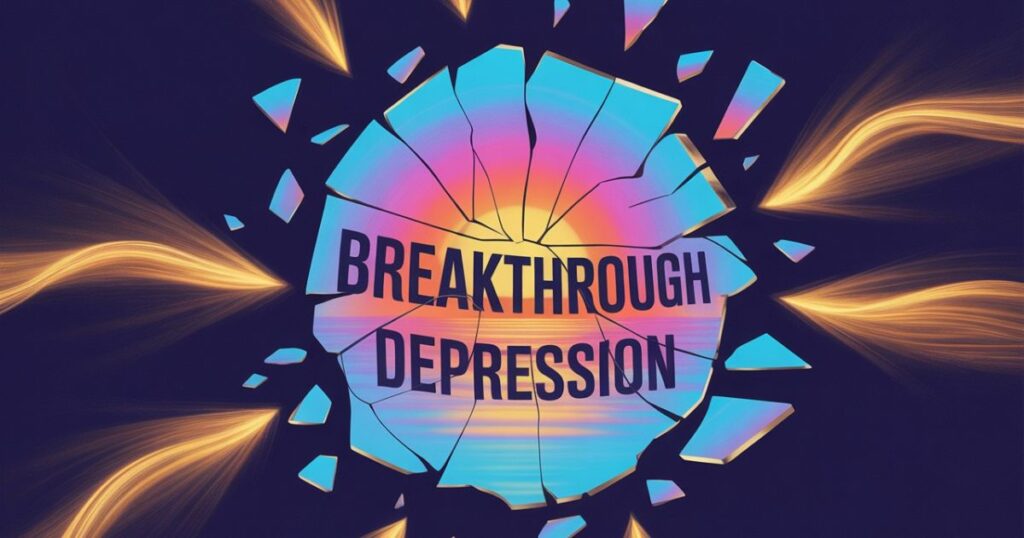What Is Breakthrough Depression?
Breakthrough depression is a concerning issue in 2025, particularly for those with major depressive disorder who have been managing their symptoms with medication. This condition happens when depressive symptom recurrence occurs despite ongoing treatment, often with SSRI antidepressants or similar medications. It can feel like a major emotional setback, causing frustration and confusion. Unlike initial treatment resistance, breakthrough depression happens after a period of feeling stable, but the symptoms suddenly reappear, leaving individuals uncertain about what went wrong.
Various factors contribute to breakthrough depression recurrence, such as neurochemical imbalances, long-term medication use, or even no adherence to medication. Stressful life events or changes in physical health can also play a role in triggering this relapse. Recognizing the signs early is crucial in managing this challenge. Seeking proper treatment options, including therapy or switching medications, is key to overcoming emotional health setbacks and regaining stability.
Why Does Breakthrough Depression Happen?
Understanding depression relapse causes means looking at both mind and medicine. Neurochemical imbalances in the brain can shift over time, making medications less effective. Some people may engage in no adherence to medication, missing doses or stopping early, which can spark a rebound in depressive feelings.
Furthermore, the placebo effect in antidepressants sometimes leads to early gains that fade. In addition, life’s stressors—job loss, illness, relational conflict—can overwhelm the brain’s capacity, undermining mental health treatment options that worked before. The result: emotional health setbacks despite ongoing care.
Common Signs and Symptoms You Shouldn’t Ignore
When managing depressive episodes, stay alert to clear signals. You might notice persistent fatigue, loss of pleasure in daily life, disturbed appetite, and poor sleep. Thoughts of hopelessness or self-harm may creep back. These are classic signs of clinical depression.
Even subtle changes—like difficulty concentrating or sudden irritability—can matter. Ignoring them kicks up the risk of full relapse. Pinpointing shifts early helps you act before symptoms deepen.
When to Seek Professional Help
If your mood dips sharply, or thoughts of worthlessness intensify, don’t wait. Reach out to a doctor, therapist, or mental health crisis helpline like 988 Lifeline if you’re in a crisis. These resources offer 24/7 support and can be lifesaving. Sharing concerns early gives providers a chance to adjust treatment before it spirals.
How Is Breakthrough Depression Diagnosed?
Diagnosing recurrence in breakthrough depression involves careful evaluation. Doctors assess history, medication history, and current mood with tools like the PHQ-9 questionnaire. Blood tests rule out physical issues like thyroid imbalance. In some cases, advanced imaging helps assess brain activity shifts.
This diagnosis is key to avoid mislabeling relapse as chronic depression. A clear picture allows the correct psychotherapy and medication combo to begin.
Self-assessment tools (link to quizzes, apps)
You can also use reliable tools at home. Apps like Mood path or questionnaires like PHQ-9 and GAD-7 help track mood shifts. They’re not replacements for professional care but empower you with insight. Regularly using them supports early detection and adjustment in treatment.
Breakthrough Depression vs. Nonresponse to Treatment
It’s vital to know the difference between breakthrough episodes and full medication-resistant depression. In breakthrough depression, you had relief before and symptoms returned. In antidepressant treatment failure, mood never lifted despite treatment.
A table may help here:
| Breakthrough Depression | Treatment-Resistant Depression |
| Initial improvement | No significant improvement |
| Symptom recurrence | Persistent depression |
| Modify dosage/timing | Try different classes |
Understanding this guides both patient and provider toward more personalized care.
Importance of understanding treatment resistance
Comprehending this distinction helps you adjust expectations and explore new paths. You may need to switch drugs or try innovative therapies. Recognizing resistance also prompts stronger reliance on cognitive behavioral therapy (CBT) and lifestyle modifications in your mood disorder management.
5+ Cutting‑Edge Treatment Options for 2025
In 2025, emerging alternatives offer hope for those facing antidepressant tolerance or relapse. These are not quick fixes, but serious innovations backed by evidence-based depression treatment.
Ketamine & Esketamine Therapy
FDA-approved nasal sprays and IV infusions reduce symptoms fast. Many report relief within hours. It works by targeting glutamate in the brain, differing from SNRI effectiveness. Clinics in the USA now offer this under medical supervision.
Psilocybin-Assisted Therapy
In some states like Oregon, this therapy is legal for resistant cases. Clinically guided use of psilocybin shows promising results in trials. It can rewire depressive patterns and improve emotional insight.
Ayahuasca — Traditional yet controversial
This plant brew used in spiritual settings offers deep emotional processing for some. It remains illegal federally but available in professional retreat settings abroad. Caution is vital due to intense psychological reactions.
Transcranial Magnetic Stimulation (TMS)
This non-invasive therapy stimulates brain regions linked to mood. TMS sessions, covered by insurance in many cases, help those who didn’t benefit from antidepressants alone.
EMDR Therapy for Trauma‑Based Depression
Originally for PTSD, EMDR is now used to treat complex depression rooted in past trauma. It uses guided eye movements to move through emotional blocks and foster healing.
New medications in clinical trials
2025’s pipeline includes dual-mechanism antidepressants and neuropeptide modulators. They aim to overcome SSRI antidepressants failures through new pathways, offering fresh hope.
Natural Remedies & Lifestyle Management
Lifestyle shifts remain vital. Healthy eating, consistent sleep, mild exercise, and meditation enhance self-care for mental health. These support the brain and work alongside other therapies.
Mood Tracking Tools for Managing Depression
Apps like Daylio, MoodKit, and Bearable help chart fluctuations. By identifying triggers and responses, they foster mindfulness. Such tools are integral for coping with depression symptoms and preventing relapse.
Daily habits to reduce relapse
Simple daily habits—morning walks, regular meals, limiting screen time at night—contribute to stability. Maintaining routine fosters resilience and counters stress, which often triggers depressive symptom recurrence.
Coping Mechanisms & Prevention Tips
Recovery is a journey. To build emotional resilience strategies, treat yourself kindly and practice realistic self-talk. Use analogies—like mental resilience being a muscle you work gently and regularly.
How to build emotional resilience
One case study: John, a veteran, learned resilience via cognitive behavioral therapy (CBT) and peer support. He built tools to fight intrusive negative thoughts. Over time, he balanced emotions under pressure and avoided deeper relapse.
Support groups, community help, apps
In the US, groups like NAMI and local Meetup circles offer shared experience and understanding. Online forums and apps like 7 Cups extend support to those without in-person access. They’re vital to support system for depression.
Quizzes to assess coping levels
Regularly taking quizzes—like stress or mood assessments—helps you gauge readiness and risk. They’re simple preventive tools. Use them monthly to stay ahead of potential setbacks.
Long-Term Outlook and Prognosis
Many people with breakthrough depression see a brighter future. The pattern may repeat, but fully recover is possible. Research shows relapse rates drop when treatment includes lifestyle elements and therapy. This hopeful view is backed by strong data.
Maintaining wellness after treatment
Stay on track with meds if prescribed. Keep therapy appointments and continue lifestyle routines. Think of it as tuning an instrument—small tweaks can keep the melody smooth. Your resilience toolkit is what sustains long-term relief.
Final Thoughts: Take Charge of Your Mental Health
You now know how to identify, diagnose, and treat breakthrough depression in 2025. This guide has covered medical options, lifestyle tools, community support, and prevention strategies. You don’t face this alone. Reach out, track your mood, and act early. Your mental health deserves attention and care.
FAQs:
1) What is breakthrough depression?
Breakthrough depression is the recurrence of depressive symptoms despite ongoing treatment with medications like SSRI antidepressants.
2) What causes breakthrough depression?
It can be caused by factors like neurochemical imbalances, nonadherence to medication, or stress, leading to a relapse in symptoms.
3) How is breakthrough depression different from treatment-resistant depression?
Breakthrough depression occurs after a period of symptom stability, while treatment-resistant depression happens when treatment fails from the start.
4) What are the symptoms of breakthrough depression?
Symptoms include feelings of sadness, loss of interest, fatigue, and changes in sleep or appetite, similar to initial depressive episodes.
5) How is breakthrough depression diagnosed?
It is diagnosed through medical history review, symptom assessment, and possibly diagnostic tools like the PHQ-9 questionnaire.
6) What treatments are available for breakthrough depression?
Treatment options include adjusting medications, adding therapies like ketamine, or incorporating cognitive behavioral therapy (CBT) for improved symptom management.



